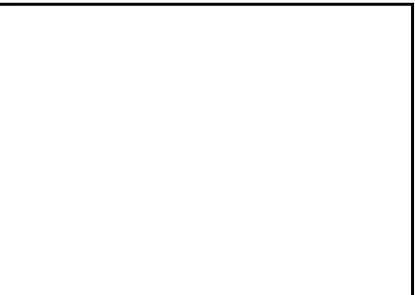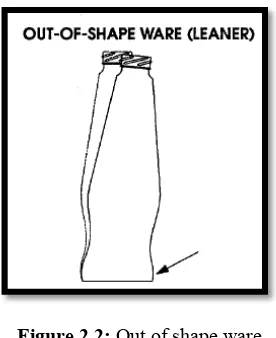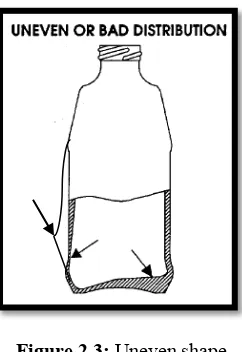UNIVERSITI TEKNIKAL MALAYSIA MELAKA
GLASS BOTTLE DEFECT DETECTION BY USING IMAGE
PROCESSING TECHNIQUE
This report submitted in accordance with requirement of the Universiti Teknikal Malaysia Melaka (UTeM) for Bachelor Degree of Manufacturing Engineering
(Robotic and Automation) (Hons)
By
AHMAD AIZAT BIN NOH B051210163
911013-14-5303
UNIVERSITI TEKNIKAL MALAYSIA MELAKA
BORANG PENGESAHAN STATUS LAPORAN PROJEK SARJANA MUDA
TAJUK: Glass Bottle Defect Detection by Using Image Processing Technique
SESI PENGAJIAN: 2014/15 Semester 2
Saya AHMAD AIZAT BIN NOH
mengaku membenarkan Laporan PSM ini disimpan di Perpustakaan Universiti Teknikal Malaysia Melaka (UTeM) dengan syarat-syarat kegunaan seperti berikut: 1. Laporan PSM adalah hak milik Universiti Teknikal Malaysia Melaka dan penulis. 2. Perpustakaan Universiti Teknikal Malaysia Melaka dibenarkan membuat salinan
untuk tujuan pengajian sahaja dengan izin penulis.
3. Perpustakaan dibenarkan membuat salinan laporan PSM ini sebagai bahan pertukaran antara institusi pengajian tinggi.
4. **Sila tandakan ( )
SULIT
TERHAD
TIDAK TERHAD
(Mengandungi maklumat yang berdarjah keselamatan atau kepentingan Malaysia sebagaimana yang termaktub dalam AKTA RAHSIA RASMI 1972)
(Mengandungi maklumat TERHAD yang telah ditentukan oleh organisasi/badan di mana penyelidikan dijalankan)
Alamat Tetap:
9-1-2, Taman Abadi Indah, Jalan 3/109c, Off Jalan Klang Lama, 58100, Kuala Lumpur
Tarikh: ________________________
Disahkan oleh:
Cop Rasmi:
DECLARATION
I hereby, declared this report entitled “Glass Bottle Defect Detection by Using Image Processing Technique” is the result of my own research expect as cited in references.
Signature : ………
Author’s Name : ………
APPROVAL
The report has been submitted to Faculty of Manufacturing Engineering of UTeM to fulfill the needed for degree of Bachelor of Manufacturing Engineering (Robotic and Automation). The
members of committee as follow:
………
(Project Supervisor)
i
ABSTRAK
ii
ABSTRACT
iii
DEDICATION
iv
ACKNOWLEDGEMENT
Praise to Allah for willing giving me the opportunity to complete this Final Year Project (FYP). As for my supervisor from Universiti Teknikal Malaysia Melaka, Mr. Ruzaidi Bin Zamri. I would like to express an appreciation for his ideas, guidance, encouragement and professionally giving constant support in ensuring this project possible and run smoothly as per planning schedule. I thanked for his patient and kindness to help me in completing my report.
Not forgotten for all lecturers and staffs of Manufacturing Engineering Department, UTeM. I very much appreciate for their comments to improve my project when I’m studying here. Sincerely thanks to them for their excellent corporation, supports and inspiration during this project. I am very lucky to have such a helpful colleagues and I never felt left out in any situation.
vi
3.4 Define problems, objectives and scopes 25
3.5 Design methodology 26-27
3.6 Develop system structure 28
3.6.1 Hardware framework 28
3.6.2 Software framework 28 3.6.2.1 Phase 1: Image acquisition 29 3.6.2.2 Phase 2: Image pre-processing 29 3.6.2.3 Phase 3: Image enhancement 30 3.6.2.4 Phase 4: Edge detector 30 3.6.2.5 Phase 5: Edge analysis 30-31 3.6.2.6 Phase 6: Object classifier 31
3.7 Summary 32
CHAPTER 4: RESULT AND DISCUSSION 33
vii
(f) Step6: Save the image capture 39
4.2.1.2 Sample of glass bottle 39 4.2.2 Software component 40 4.2.2.1 Phase 2: Image pre-processing 40 4.2.2.2 Phase 3: Image enhancement 41 4.2.2.3 Phase 4: Edge detector method 41 4.2.2.4 Phase 5: Edge analysis 42
(a) Label the blob (circle) 42
(b) Condition 1: Number of blob (circle) ≥ 3 43-45
(c) Condition 2: Measurement analysis 46-54
4.2.2.5 Phase 6: Object classifier 55
(a) Graphical user interface (GUI) 55-56
4.3 System effective percentage 57
4.3.1 Outer circle effective percentage 57
4.3.2 Inner circle effective percentage 57
CHAPTER 5: CONCLUSION AND FUTURE WORK 58
5.1 Conclusion 58
5.2 Limitation 59
5.3 Suggestion and future development 60
REFERENCES 61-64
APPENDICES 65
A Gant chart 66-67
B MatLab Code (without Graphical User Interface) 68-70 C Sample image of the glass bottle 71-76 D MatLab Code (Graphical User Interface) 77-81
viii
3.1 Reference good glass bottle 31
4.1
Measurement of the sample Image pre-processing
Condition 1(Number of blob (circle) ≥ 3 ) Data of Number of blob
ix
Hardware and software component for demonstration Flow chart of software and hardware component
Field of Vision setting Optical Chart
Camera Box Setting Light Emit Diode (LED) Guide for glass bottle position Sample position
Monitoring sample Image Acquisition
x
Graph of Outer Circle Diameter Graph of Inner Circle Diameter Inner Circle Diameter Error Inner Circle Area Error
Graph of Inner Circle Diameter Graph of Inner Circle Area Sample 4 inner circle defect Sample 7 inner circle defect Graphical user interface (GUI) Good Sample loaded in GUI Defect Sample loaded in GUI
xi
LIST OF ABBREVIATIONS AND SYMBOLS
GUI - Graphical user interface CCD camera - Charge-couples device camera LED - Light emitting diode
% - Percent
1
CHAPTER 1
INTRODUCTION
.
1.1 Background of study
Recently, technology has evolved to the new stage and changed the character of manufacturing industry. In the past, manufacturing and the fabrication process were all done by manually and operated by a human. Since the computer and technology has been applied in the industry, automation has turn the competitive beneficial in today‟s manufacturing. The benefit for the companies who applied automation in their companies enables the companies to mass produce of products with the high speed, repeatability and better quality output. This also makes the automation as the factor that determine the strong competitive between the companies in the manufacturing industry whether the each companies can hold in the storm of competitiveness. Automation study are emphasizes on the capability, productiveness, quality and reliability, also focusing on systems that operate independently, often in structured environments over extended periods and on the explicit structuring of such environments.(Goldberg, 2012).
2
the customer. Quality control has a very their own benefit such as increased the productivity for example poka yoke, a mechanism that use to help an equipment operator avoid mistake. By increasing the productivity, it also increases the profit of the company by reducing the rejection and repair of the product.
In manufacturing industry, the inspection system is developed as an application to identify the defects occurs on the product and if the defects is recognize then it must be sort into another path for correction or rejection, this may increase the quality of the production system. Inspection system is divided into two which is manual system and automated system. Before the automated system is develop, people are the one who use to do manual system of the product by following the procedure. The manual system is a system that relies on the action of people which would increase the possibly human error to occur. An error is defined as “An action that unintentionally departs from an expected behavior” and it‟s mostly done by human. The system also operated in low speed because human response is slow than automated system and this may slow the productivity of the product. Human tend to make an error because human need to be trained to gain an experience and sometimes error can be happen, this may cause the output result inaccurate.
3
The automated system can do work fast because the system can process the information than human being. It also can do the repetitive work without getting tired and fell bored due to continuous power supply, compare to human that may fail to finish the job properly if getting tired. Using automated system also increase the safety of the worker by placing in the dangerous area like the space or power plant. The accuracy of automated system is beyond human because with a vision system applied on the machine, it can stay sharp and focus to detect and identified item with a quick response. According to Tai-shan, Xu-huai, Hong-min, & Jia-wei, (2012), by using machine vision system it can do online detection where the product is inspect on the real time environment without need of touching the detecting product. The system can run with high speed, good accuracy and good flexibility in automatic detection product detection.
This project is about on how to detect defect glass bottle and sent a warning signal if the glass bottle defect is identify. Liu & Wang, (2008) state that there are various kinds of glass bottle products that been produce for food and drink container. For example, the production output of beer in China in 2007 has surpassed 39 million tons and the majority of the beer is canned with glass bottle. Therefore, inspection is required in order to maintain the quality of high demand production but in many cases the work inspection is usually done by manual and will increase the labor cost also the inspection quality also low.
1.2 Problem statement
4
the glass bottle just using one method only to replace both mechanisms and identify the parameter without need of touching and rolling on the product.
1.3 Objective
There are two objectives during conducting the project:
i. To build vision system that can detect the hole and body roundness of the glass bottle.
ii. To develop Matlab coding which can classify the circle and pixel measurement of the glass bottle.
1.4 Scope
5
1.5 Report Structure
This report is divided to three major chapters which are introduction, literature review and methodology. As for report structure, each chapter will be explained.
Here are some short reviews in subsequent chapters. Chapter 1 will be divided into five categories which are background of study, problem statement, objective and scope. Firstly, in background will discussed about the general idea about the project. Next, is problem statement which explains the current issues that need to be addressed before solving the problem. Next, the objective is set to achieve the goal of the. Lastly, the scope will explain the range of the project based on the student capabilities. As for report structure, each chapter will be explained.
Chapter 2 will discuss on literature review which focusing on the previous project details, analysis and study related information for this particular project. This chapter also will review the critical points of current knowledge which include any point of view from previous researcher and their findings that contribute to a particular topic.
Chapter 3 will discussed about the methodology used to fulfil the objective and the scope of the project. In this chapter will include flow chart which illustrates the project progress from the beginning through the end of the project. It will be some explanation regarding a process of making the project.
Chapter 4 will discussed the results obtained through the experiments that have been designed in methodology.
6
CHAPTER 2
LITERATURE REVIEW
2.1 Introduction
In this chapter, it will show all the relevant overview of the method that will be used in order to achieve the objective. The detail review of vision system that currently develops in industry will be showed in this chapter where all of the information from different kind of sources such as the journal, reference book, internet, and others will be used. All the information are used to design the methodology in chapter three, that chapter will focused on the design and development of the system in vision machine.
2.2 Production process glass bottle
7
Figure 2.1: Glass forming process (Source: Ty Nant Spring Water (2014). Retrieved from
http://www.tynant.com/main.aspx?pID=39-0)
8
2.3 Defect on glass bottle
A good glass bottle is when the product is pass the quality control line without causing any difficulty and proceeds to next process which is packaging process. There are many type of defects that can occur during the production process and some of it is beyond the control of operator and the largest number occur either in the feeder or machine operation. (Glass container defects – Causes & Remedies (1967), section 1, pp.1).
In this project, the inspection on the glass bottle is only based on the diameter of the hole and roundness of the glass bottle because it going to replace both inspection mechanisms rolling and touching on the glass bottle.
This project covered only the general defect of the glass bottle, such as:
2.3.1 Out of shape ware (leaner)
Figure 2.2: Out of shape ware
(Glass container defects – Causes & Remedies (1967), section 7, pp.136)
9
time to be cool down, where the machine speed is too high, the product not hanging in the takeout long enough and blow mold cycle too short. Thirdly, the mold equipment is incorrect shape of the blow and blank design of the mold. Lastly, the conveyor there is incorrect cooling over the deadplate. (Glass container defects – Causes & Remedies (1967), section 7, pp.136-137)
2.3.2 Uneven or bad distribution
Figure 2.3: Uneven shape
(Glass container defects – Causes &Remedies (1967), section 7, pp.138)


